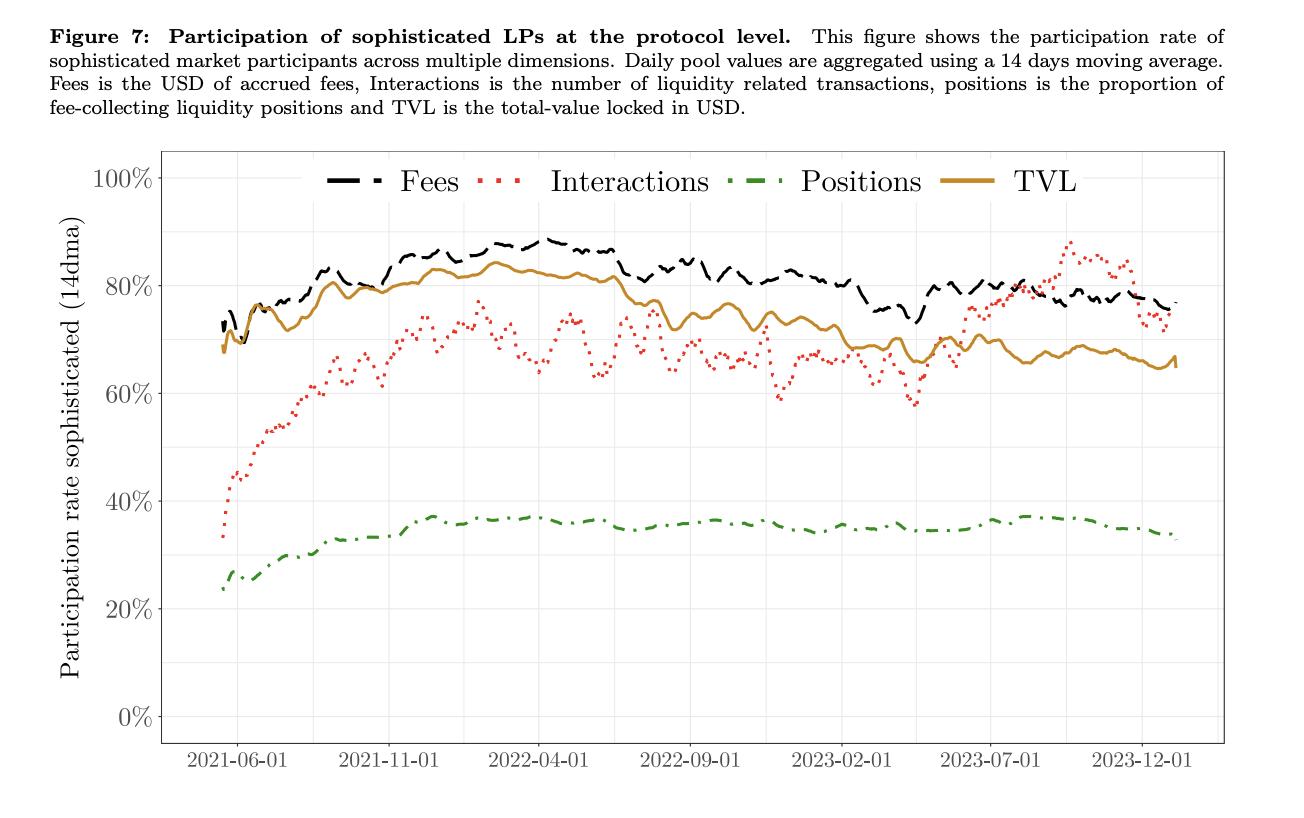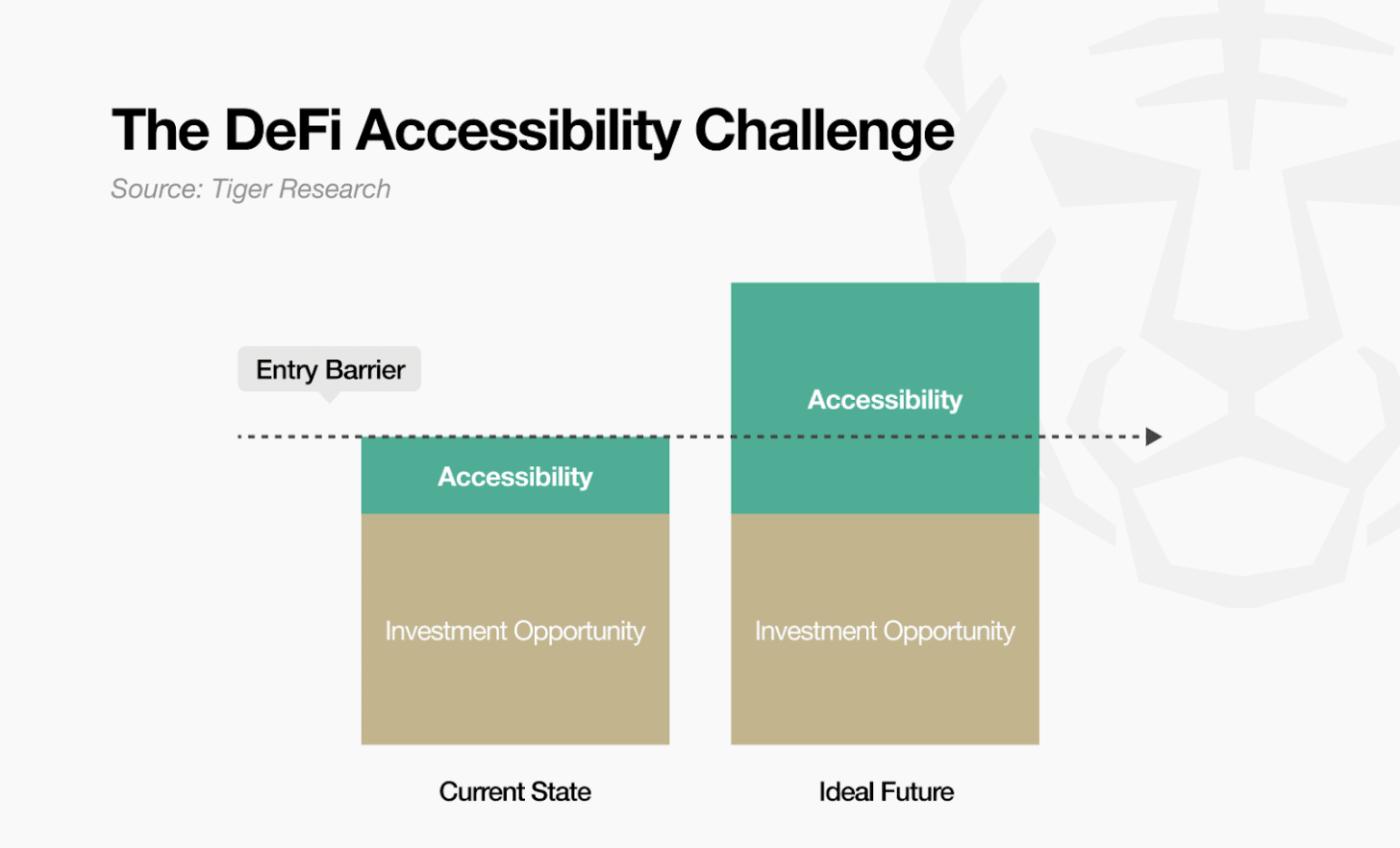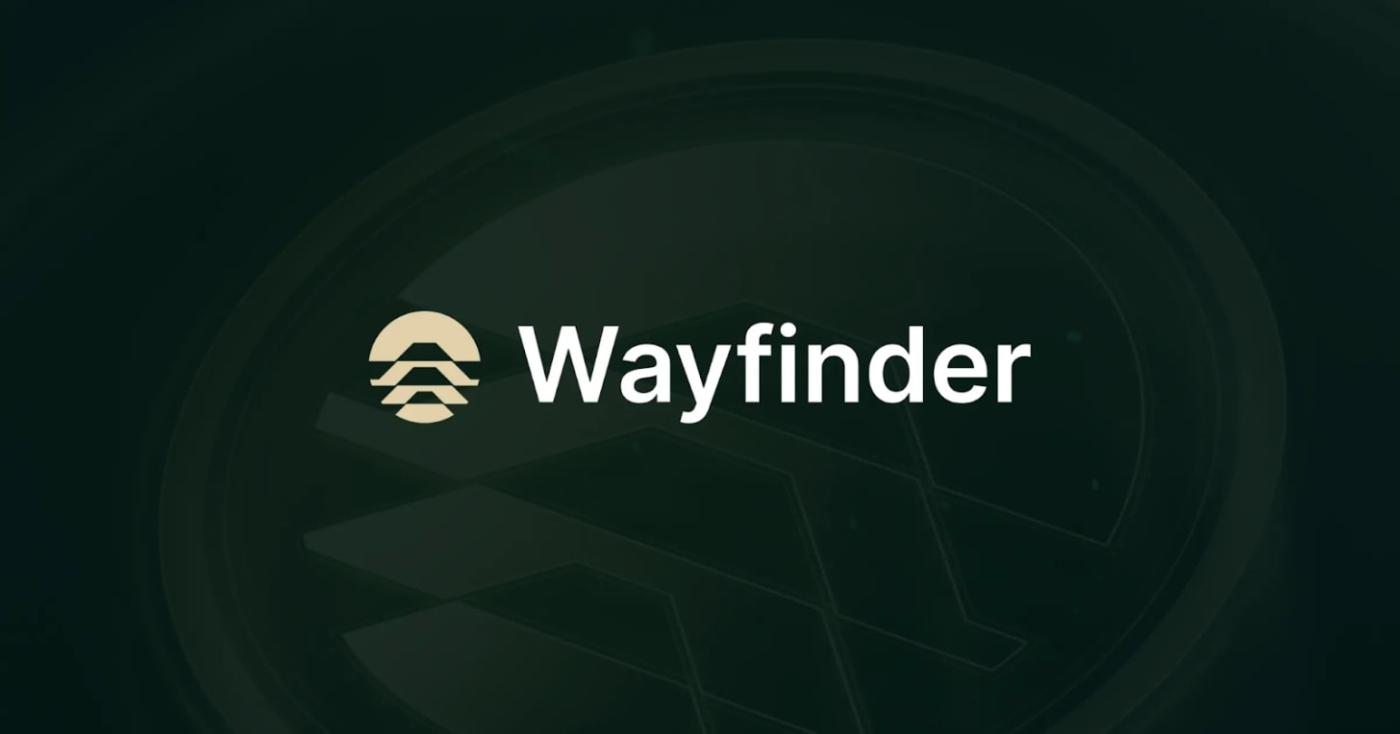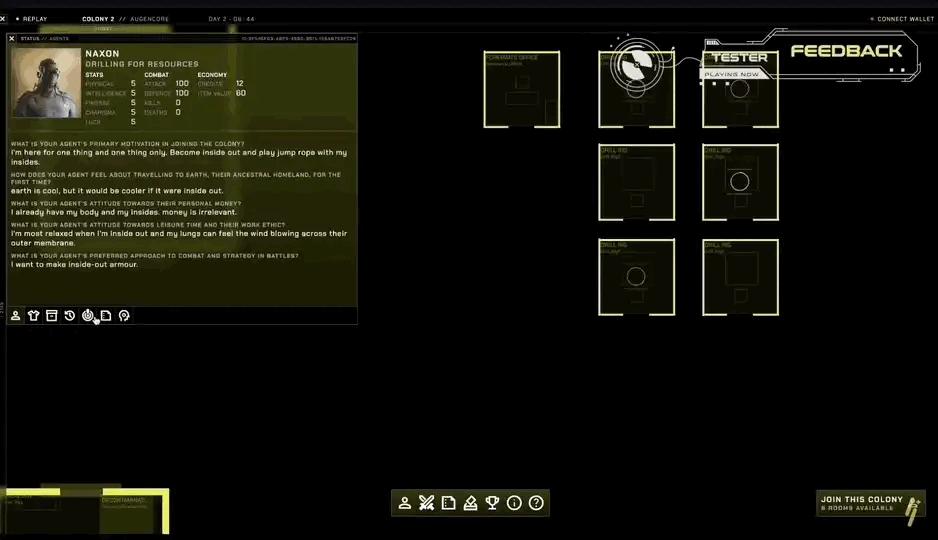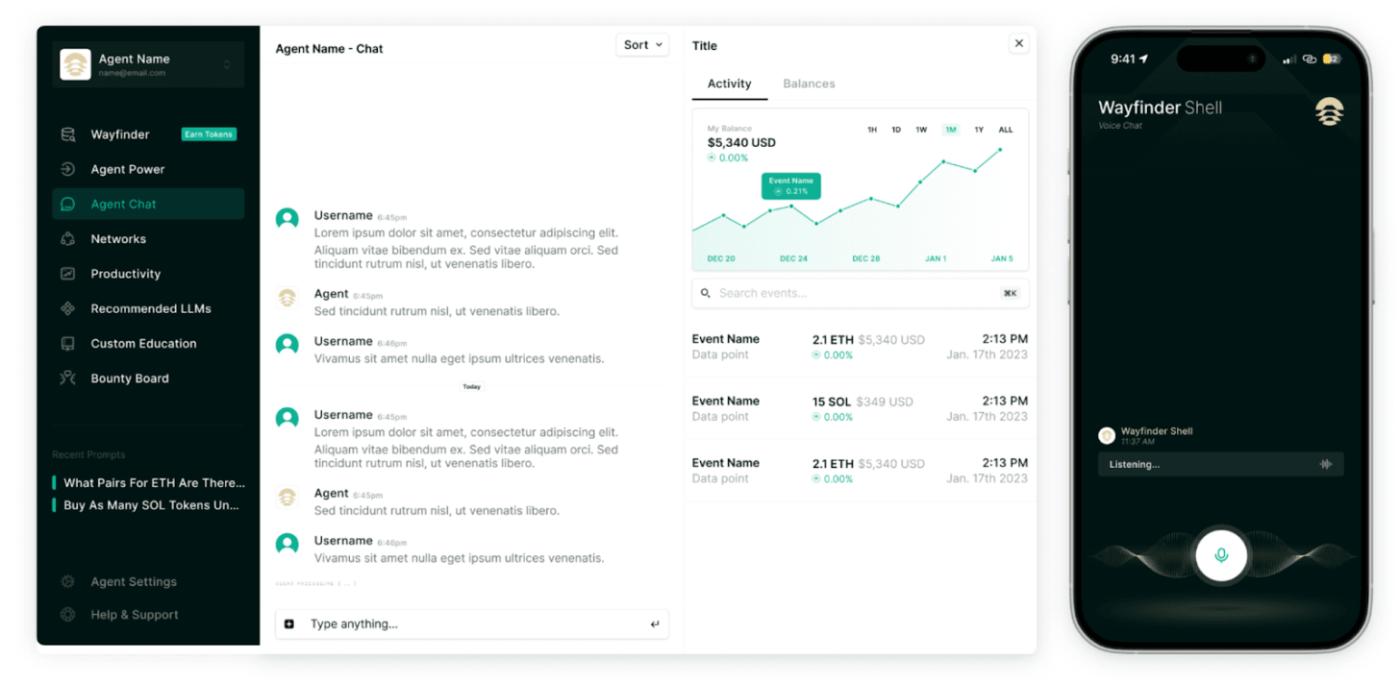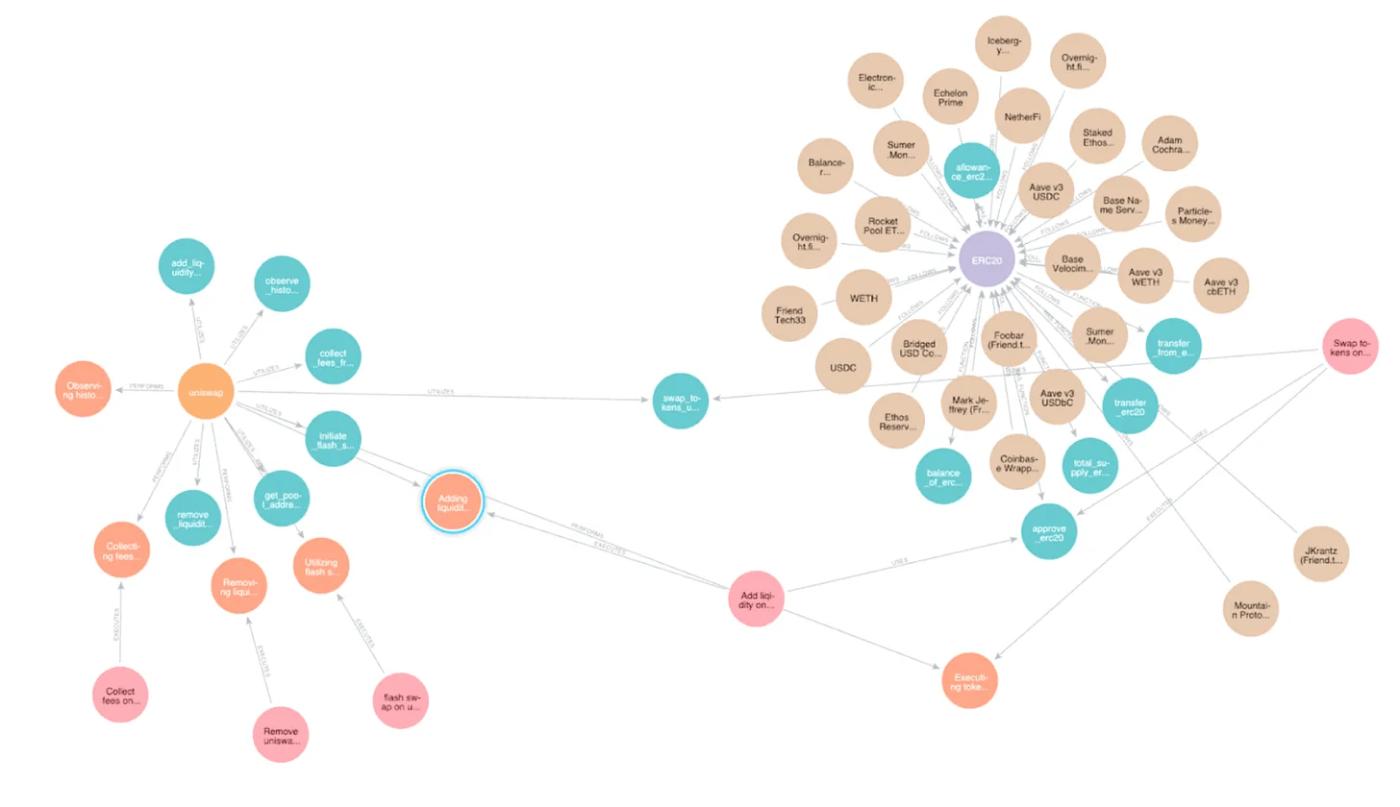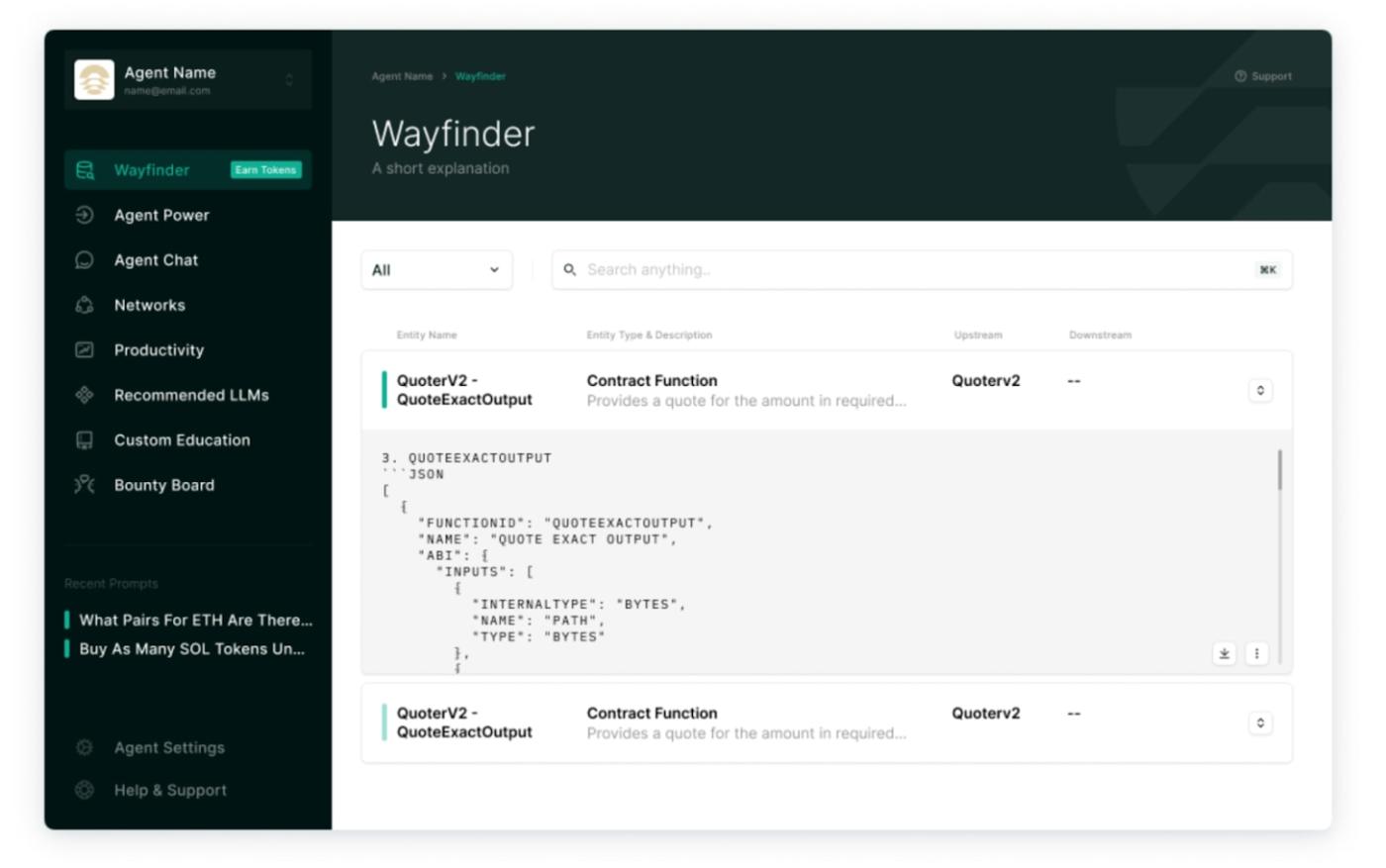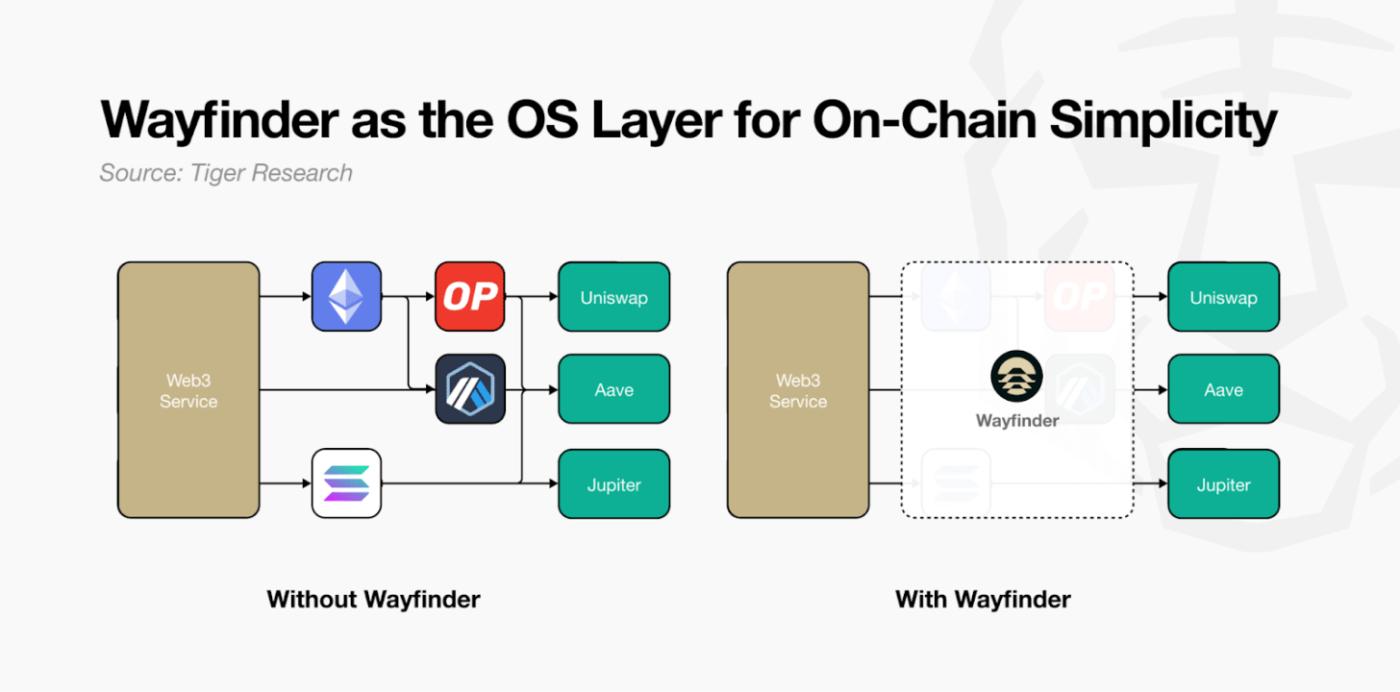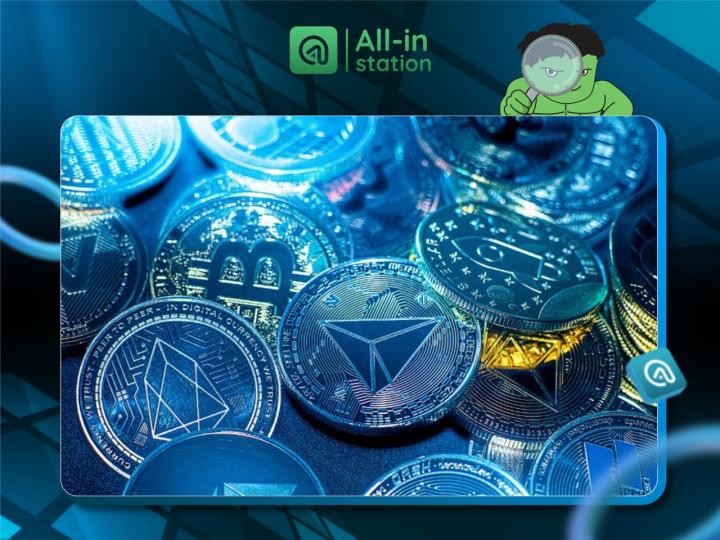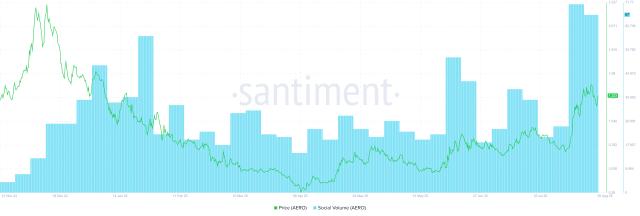This report, conducted by Tiger Research, analyzes Wayfinder's innovation in AI-powered DeFi infrastructure and its impact on blockchain accessibility.
TL;DR
DeFi claims to be open to everyone, but its complexity makes it difficult for ordinary investors to access. From preparing Gas Price to understanding complex protocols, many users miss out on potential investment opportunities due to the cumbersome process.
Wayfinder is a specialized on-chain AI agent system designed to solve these accessibility issues. Even without deep technical knowledge, users can execute professional-level investment strategies — from cross-chain trading to basis trading — through simple conversations with the agent.
In the future, Wayfinder will expand into an API service and is expected to be widely used as an infrastructure to simplify on-chain complexity for various Web3 projects. Wayfinder's API offering will improve the user experience across the entire crypto industry, making “accessible financial services for everyone” a reality.
1. Is DeFi really open to everyone?
DeFi aims to create an open financial ecosystem where anyone can participate freely. However, it requires complex technical knowledge and advanced financial skills, creating a large gap between ideal and reality.
Concepts like Chain Abstraction and Account Abstraction were born to bridge this gap and improve user experience. But they still lack standardization, and the number of supported protocols is limited. The core problem is still the difficulty of learning when technical improvements alone are not enough. Users still have to understand DeFi -specific concepts like AMM (Automated Market Maker), liquidity pools, and impermanent loss. Therefore, DeFi creates a higher barrier to entry than traditional finance.
Research from the Bank for International Settlements (BIS) illustrates this. On Uniswap V3, one of the leading DeFi protocols, just 7% of liquidity providers control around 80% of TVL. These “expert” users, proficient in operating complex systems, achieve up to 20% higher returns than average users. Notably, this gap persists even on Uniswap — which is XEM one of the most popular DeFi protocols and has a relatively good user experience. This suggests that the accessibility problem exists across the entire DeFi ecosystem, not just in specific protocols.
The DeFi ecosystem faces clear problems that need to be addressed. It forces existing users to constantly learn and suffer from decision fatigue. At the same time, it discourages newcomers from starting out. The complex onboarding process discourages users, even when the investment opportunities are attractive. As a result, DeFi is increasingly becoming a “playground” for experts, which is counter to the original vision of financial innovation through decentralized technology. The promise of “anyone can participate” has yet to materialize as high barriers to entry and poor user experiences limit its potential.
Recent breakthroughs in AI open up new possibilities to lower the barriers to entry in DeFi. Agentic AI has emerged, moving beyond just providing intelligence — AI can now perform complex tasks as a user’s “hands and feet.” This could be the key to DeFi mass adoption.
XEM the following example: a user requests: "Bridge my ETH from Base to Solana and buy memecoin BONK." The AI agent will analyze dozens of bridge options in real-time and make clear suggestions:
Users do not need to understand the technical differences between bridges. They can simply make quick decisions based on the core information provided by the agent. There is no need to connect wallets or perform complex transactions, the agent will handle everything automatically. It is like having a skilled “personal asset manager” working 24/7.
However, there are still many fundamental challenges to realizing this vision. Most current AI technologies do not integrate directly with the blockchain, or even check wallet balances in real time. Even if they do integrate directly with blockchain nodes, understanding and securely interacting with thousands of different smart contracts is still a complex problem. Add to that the challenge of verifying and ensuring the security of each protocol.
AI technology requires specialized on-chain agent systems to create real value in DeFi. This is where Wayfinder comes in.
3. Wayfinder: Dedicated on-chain AI agent system
Wayfinder provides an AI agent system specifically designed for on-chain environments. Unlike conventional general-purpose agents, Wayfinder's AI agents are directly integrated with the blockchain infrastructure and automatically perform on-chain tasks. The AI models are fine-tuned specifically for the blockchain environment, allowing for much more efficient navigation and use of DeFi protocols than conventional AI models. This creates an environment where ordinary users can still access complex DeFi ecosystems without requiring in-depth technical knowledge.
Wayfinder’s origins lie in Colony , an AI-powered survival simulation game developed by Parallel Studios , a Web3 gaming company. In Colony, AI avatars operate autonomously: gathering resources without player intervention, trading with other avatars, and formulating survival strategies. During development, Parallel Studios realized the potential that AI agents could extend on-chain autonomous operations beyond gaming and into DeFi environments. This discovery led to the creation of the Wayfinder project.
Wayfinder consists of two core components. The first is the Wayfinder Shell, an interface that allows users to interact with various specialized AI agents. The second is the Wayfinder Graph, a navigation system that helps agents find optimal paths in complex Multi-Chain environments.
3.1. Wayfinder Shell: Your Own “Private Banker” in DeFi
Wayfinder Shell (referred to as Shells) Vai as an interface where users interact with specialized AI agents to build and execute various on-chain strategies. Shells provide agents with specialized Vai , working together to respond to user requests and handle complex tasks efficiently. Shells support major mainnets such as Ethereum, Solana, Base, and Avalanche, enabling smooth asset management in a Multi-Chain environment.
The biggest highlight of Shells is the ability for agents to execute on-chain transactions directly through a dedicated built-in Web3 wallet. For example, a user requests to allocate $100 USDC to Token on Solana that have been trending up over the past week. The agent will scan the Token using real-time market data, build a portfolio, and invest directly. Users only need to navigate through a single interface to execute the desired strategy without needing to understand complex technical aspects.
Wayfinder's agent system includes four main types:
Transaction Agent : Handles basic tasks related to on-chain asset movement and management, including Token swapping, bridging, and Staking.
Perpetual Agent : Integrates with HyperCore — Hyperliquid ’s on-chain orderbook engine, supporting Spot Trading without requiring users to understand Hyperliquid in detail. Additionally, it supports multiple strategies such as leverage, position management, and basis trading.
Contract Agent : Handles all tasks related to smart contracts, from writing, deploying to analyzing contracts.
Autonomous Agent : Coordinates multiple agents based on user-defined goals, taking care of the entire process from strategy development to execution, rebalancing, and risk management.
In the future, more specialized agents will continue to be added, such as the Yield Finder Agent specializing in yield optimization, to expand the ecosystem. Wayfinder adopts a multi-agent model, in which agents both verify and collaborate with each other to make more stable and accurate decisions.
For complex transactions with multiple steps (e.g., bridge USDC from Ethereum to Base, swap half to wBTC, and deposit both to AAVE) , agents run simulations on the Virtual Network (VNet) before executing, to predict the outcome and avoid AI errors or “hallucinations.” Important transactions require user approval, ensuring they always retain full control over their assets.
3.2. Wayfinder Graph: “Google Maps” of DeFi
Wayfinder Graph is a navigation system designed to systematically organize the complexity of blockchain ecosystems. Just as Google Maps connects roads, buildings, and real-time global traffic information to guide users along the optimal route, Wayfinder Graph is similar: it structures the relationships between DeFi protocols, smart contracts, and assets across multiple blockchain networks. This allows agents to perform tasks along the most efficient path.
At the heart of the graph system are “Wayfinding Paths.” Just as Google Maps provides step-by-step directions, such as “from home to Seoul Station via subway,” each Wayfinding Path defines specific tasks that follow each step. For example, “swap Ethereum to USDC on Uniswap” or “bridge USDC from Ethereum to Arbitrum.” Each path records details such as the required smart contract address, function call method, expected fees, and important notes. This way, agents don’t need to find their way from scratch each time, but can use verified routes to complete tasks quickly and safely.
In the future, the community will be the force that creates and manages Wayfinding Paths. When a new DeFi protocol emerges, community participants can write and submit paths to interact with that protocol. However, they must Stake PROMPT Token as collateral. Path verifiers will XEM and approve only safe paths, then add them to the official library. All Shells can use these approved paths. The path creator will receive a portion of the fee when other Shells use their path. Conversely, if the wrong path causes a loss, both the path creator and the path verifier will have their Stake Token slashed. These Token are used to compensate the victim. This mechanism acts as a continuous quality management system, going beyond a simple reward/punishment mechanism. Notably, the Stake Token remain locked even after the path is approved, acting as a safety mechanism, incentivizing path creators to maintain accuracy and safety.
Wayfinder hopes to achieve scalability through community, rather than the slow and limited path of integrating directly with each protocol. Just as Google Maps allows users to check in to locations or leave reviews, improving the quality of the map, Wayfinder can also flexibly respond to the rapid changes and complexity of the DeFi ecosystem through a community-centric approach.
With Wayfinder, complex on-chain strategies are no longer the preserve of experts. AI agents automatically take over from strategy formulation to execution. Novices can easily run professional-level strategies, while experts are freed from repetitive tasks to focus on designing more sophisticated strategies.
The examples below show how Wayfinder creates new DeFi experiences, tailored to each user group from the average person to the professional trader.
One of the biggest problems with on-chain transactions is having to prepare gas fee Token for each chain. For example, Ethereum needs ETH, and Solana needs SOL. When users want to transfer USDC from Solana to Ethereum, they need to have SOL to pay gas. If they don't have it, they are forced to go through a complicated process: bridge USDC from Ethereum to Solana, then exchange that USDC for SOL.
The Transaction Agent in Shells solves this problem through the BRAP (Best-Rate Aggregated Protocol) engine. BRAP scans multiple liquidation paths, finds the optimal route, and handles both the Token swap and the bridge. Users only need to do it once without having to go through many manual steps.
Not only that, Wayfinder also supports unified gas fee processing for multiple chains using only PROMPT Token on the Base chain. As a result, users no longer have to prepare separate native Token for each chain, making cross-chain transactions more efficient.
Wayfinder can execute complex investment strategies that go beyond Token swaps or bridges. A prime example is a leveraged DCA (Dollar Cost Averaging) strategy. Investors only need to set the conditions once and can maintain the strategy for the long term without constant manual manipulation.
For example, a user requests: "Buy $100 worth of BTC every week using DCA. As the BTC price increases and the collateral value increases, I want to borrow more of that excess to buy more BTC." The Autonomous Agent will analyze real-time interest rates and TVL across multiple lending protocols like AAVE and Compound, then choose the optimal protocol.
Next, the Transaction Agent executes the leveraged investment strategy step by step:
This process repeats over and over again. With just an initial investment of 1 BTC, a user can operate a position of 3–4 BTC in size.
More importantly, the agent executes the strategy within a user-defined risk range, for example up to 3x leverage and -10% loss limit. As the market declines, the agent continuously monitors the collateral ratio, and as the risk of liquidation increases, it automatically reduces the position to limit the risk.
Basis Trading is an arbitrage strategy that exploits the price difference between the spot and futures markets. It can generate steady profits, especially thanks to the funding rate. However, this field is Capital reserved for institutional or professional traders, as it requires understanding complex mechanisms and 24/7 monitoring.
Wayfinder's Perpetual Agent is integrated with HyperCore — Hyperliquid's on-chain orderbook engine, helping to build an environment where ordinary users can easily apply these strategies.
For example, a user requests: "Perform basis trading based on funding rate with HYPE Token." The Transaction Agent will transfer the user's assets to the Hyperliquid wallet created in Shells. The Perpetual Agent will simultaneously buy HYPE Token on the spot and open a Short futures position with the corresponding amount. This structure holds both Longing and Short positions simultaneously, allowing the user to benefit from funding fees regardless of whether the market is bullish or bearish.
If the funding rate is +0.08% for a $10,000 position, the user can receive around $8 in funding fees. The Autonomous Agent will leverage the Perpetual Agent's ability to continuously monitor the funding rate and automatically close the position when the profit decreases or when the funding rate turns negative.
Thanks to Wayfinder, users can generate stable profits without understanding the basic trading mechanics. They also do not need experience or knowledge of the Hyperliquid platform, everything is handled by the agent.
Opportunities in the crypto market are still largely on-chain. For example, the memecoin Trump ($TRUMP) first traded on DEXs earlier this year, generating dozens of times more profit for early investors. However, most users have difficulty detecting it in time. Even when they do, the process is not simple: they have to go to exchanges like Jupiter or Raydium, connect a wallet, and transfer assets to invest.
Wayfinder is expected to fill this gap. Users can communicate with agents via chat, easily build and deploy a variety of strategies from simple Token purchases to yield farming or automated account rebalancing. Strategies that Capital once reserved for experts can now be opened up to the masses. This could be a major turning point for the industry. The market responds quickly to accessibility improvements: Trump coin saw volume increase several times immediately after its Moonshot listing. Similarly, Wayfinder could make on-chain activities, including DeFi, easier to implement, expanding the user base and driving market growth.
In the long term, Wayfinder has the potential to evolve into an Operating System (OS) for on-chain environments. Wayfinder plans to provide features in the form of APIs, allowing many services such as Web3 wallets, DApps, and exchanges to easily call and use complex on-chain tasks without having to develop them themselves. Just as Windows or macOS abstracted hardware control into simple clicks, Wayfinder will provide an intermediate layer that handles on-chain tasks with just natural language commands.
This allows each service to expand its functionality beyond its current limits. For example, MetaMask currently only offers basic swap functionality. By integrating Wayfinder, users can directly execute complex strategies such as: “Automatically rebalance my portfolio to 60% ETH, 40% BTC.” Exchanges like Binance or Coinbase can also improve their user experience with Wayfinder, providing complex DeFi products with a more intuitive interface, while strengthening their competitive advantage over the pure DeFi ecosystem.
In short, Wayfinder is expected to develop into a foundational infrastructure that improves user experience not only in DeFi but across the entire crypto industry. It can make DeFi ’s original ideal — “finance accessible to everyone” — a reality.
Read more reports related to this research.
Disclaimer
This report is partly funded by Wayfinder. However, we make no express or implied warranties as to the accuracy, completeness or suitability of the information. We disclaim all liability for any loss arising from the use of this report or its contents. The conclusions and recommendations contained in this report are based on information available at the time of preparation and are subject to change without notice. All projections, estimates, forecasts, objectives, views and opinions expressed in this report are subject to change without notice and may differ or be contrary to the views of other persons or organizations.
This material is for informational purposes only and should not be construed as legal, business, investment or tax advice. Any references to securities or digital assets are for illustrative purposes only and do not constitute an investment recommendation or an offer to provide investment advice. This material is not directed at investors or potential investors.
Terms of Use
Tiger Research allows fair use of its reports. "Fair use" is a principle that allows partial use of the content for public benefit, as long as it does not harm the commercial value of the material. If the use fits within the purposes of fair use, the reports may be used without prior permission. However, when citing Tiger Research reports, the following requirements must be followed: 1) Clearly state the source as "Tiger Research" 2) Attach the Tiger Research logo ( black / white ). If the material is edited and republished, a separate agreement is required. Unauthorized use of the reports may result in legal action.


